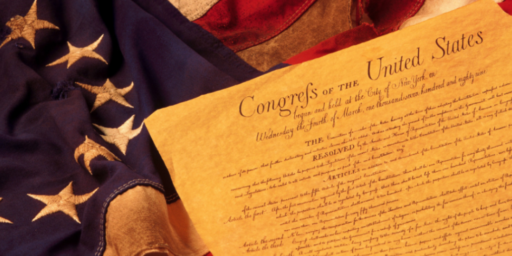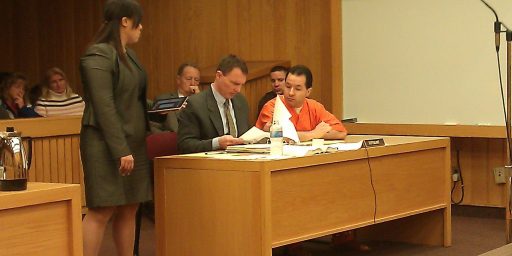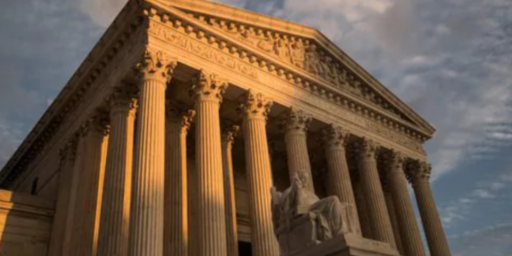Supreme Court Agrees to Hear Civil Asset Forfeiture Case
We may finally get a ruling applying the Excessive Fine Clause to the states and limiting the ability of police to confiscate property.

Earlier this week, the Supreme Court agreed to hear a case involving one of the most egregious practices in local law enforcement.
Reason‘s Damon Root explains:
The case is Timbs v. Indiana. It arose in 2013 when a man named Tyson Timbs was arrested on drug charges and sentenced to one year on home detention and five years on probation. A few months after his arrest, the state of Indiana also moved to seize Timbs’ brand new Land Rover LR2, a vehicle worth around $40,000. A state trial court rejected that civil asset forfeiture effort, however, on the grounds that it would be “grossly disproportionate to the gravity of [Timbs’] offense” and therefore in violation of the Eighth Amendment to the U.S. Constitution, which forbids the imposition of “excessive fines.”
The state’s forfeiture effort clearly qualifies as excessive. Timbs’ original crime carried a maximum financial penalty of just $10,000. And as the trial court observed, “a forfeiture of approximately four (4) times the maximum monetary fine is disproportional.” The trial court was right to deem the state’s actions unconstitutional.
But the Indiana Supreme Court took a different view when it decided the case in 2017. “We conclude the Excessive Fines Clause does not bar the State from forfeiting Defendant’s vehicle because the United States Supreme Court has not held that the Clause applies to the States through the Fourteenth Amendment,” that court said.
Timbs, represented by the libertarian lawyers at the Institute for Justice, then asked the U.S. Supreme Court to clarify that the Eighth Amendment’s ban on excessive fines does indeed apply in all 50 states.
UCLA lawprof Eugene Volokh, who has filed an amicus brief on the side of Timbs, argues that it should. His post is basically the brief minus footnotes and is worth reading in full. But here are some highlights:
Most recently, in McDonald v. City of Chicago, the Court held that the Second Amendment applies to the states. Thus, right now,
- all the Bill of Rights provisions in the first eight Amendments are incorporated against the states,
- except three provisions that the Court has expressly said are not incorporated — the Fifth Amendment’s Grand Jury Clause, the requirement of jury unanimity that has been read into the Sixth Amendment’s Criminal Jury Clause, and the Seventh Amendment, which provides for civil juries —
- and two provisions on which the Court hasn’t spoken: the Third Amendment, which limits the quartering of soldiers in people’s homes, and the Eighth Amendment’s Excessive Fines Clause.
[…]
Sovereigns are always thirsty for money, and fines and forfeitures are often an easy way to get this money. Fines and forfeitures are thus especially likely to be abused—which is why the forerunner of the Excessive Fines Clause in Anglo-American law dates back to Magna Carta.
Today, the system of targeting the poor with fines and then imposing “poverty penalties” generates huge sums for states and localities, as do forfeitures. They operate as regressive taxes—where those with the least ability to pay end up paying the most.
And these practices are especially politically appealing because they reduce taxes for the wider population, while burdening those who are least likely to push back. The poor, who are most effected by excessive fines and forfeitures, are also among the least likely to vote. They are less likely to acquire political power in other ways, such as through contributing to political campaigns. They are less likely to have friends in high places. And people with a criminal record may often be unable to regain their voting rights if they fail to pay their criminal debts. Laws in thirty-four states allow for continued disenfranchisement due to outstanding criminal debt regardless of whether the would-be voter has any meaningful ability to pay.
[…]
And just as state legislatures have an incentive to create laws that lead to excessive fines and forfeitures, state courts have an incentive not to police them. Indeed, fines often fund the courts themselves. Particularly in budget-strapped times, some governments become dependent on revenue from economic sanctions. One report noted that the “Nevada Supreme Court recently went broke because revenue from traffic tickets plummeted, and the city of San Jose, California, lamented the drop in traffic violation revenue.” An Oklahoma County District Judge was recently quoted as saying, “Today, we fund probably 90 percent or more of the operation of the courts actually out of the money that the court collects.”
Similarly, prosecutors and law enforcement often directly receive forfeiture funds, and this often leads to distorted priorities. For example, earlier this year a bill was filed in Alabama’s legislature that would require a conviction prior to forfeiture and that would place revenue from forfeitures in the state’s general fund. In response, the presidents of the Alabama District Attorneys Association and Alabama Sheriffs Association publicly stated that, if the bill was passed, prosecutors would file criminal charges in nonviolent and drug-offense cases against people who they otherwise would have believed better served by diversion programs, and law enforcement would stop policing drug and property crimes. Without receiving forfeiture funds, the groups reasoned, “[w]hat incentive would local police and sheriffs have to invest manpower, resources and time in these operations?”
Ilya Somin, a George Mason lawprof and Volokh Conspirator, thinks the case should be a slam dunk.
Rejecting incorporation of the Excessive Fines Clause would be an extreme anomaly at a time when the Court has already incorporated both the rest of the Eighth Amendment (which forbids “excessive bail” and “cruel and unusual punishment”), and also every other provision of the Bill of Rights that protects property rights. It would be especially strange to conclude that the Excessive Bail Clause is incorporated while the Excessive Fines Clause is not.
The Supreme Court’s current test for determining what parts of the Bill of Rights to incorporate under the Due Process Clause of the Fourteenth Amendment was most recently restated in McDonald v. City of Chicago (2010), which incorporated the Second Amendment right to bear arms. It requires the court to consider whether the right in question is “fundamental to our scheme of ordered liberty.” Protecting property rights against overreaching governments seeking to impose vastly disproportionate fines was clearly seen as a fundamental value by the Founders who drafted the Bill Rights, and by the framers and ratifiers of the Fourteenth Amendment. If you prefer a less originalist and more “living constitutionalist” approach to the test, it’s worth noting the widespread opposition to asset forfeiture abuse today, which unites such disparate groups as the ACLU, the NAACP, libertarians, and many conservatives. The same result applies if you prefer the alternative approach to incorporation favored by Justice Clarence Thomas and many legal scholars: using the Privileges or Immunities Clause, rather than the Due Process Clause. As Thomas notes in his concurring opinion in McDonald, property rights are among the “privileges or immunities” of citizens that the Clause was intended to protect. Thomas is also a longtime critic of asset forfeiture abuse, and has repeteadly argued for stronger exercise of judicial review to curb it.
In sum, it would be very surprising if the Court ruled against incorporation. Indeed, I would be surprised if there were more than one or two votes against it, and a unanimous decision on that issue is entirely possible.
He concedes that the inclusion of asset forfeitures, which the Court has thus far considered a “fine” only in limited circumstances, is harder. But he makes a strong case as to why they should do so:
Asset forfeiture technically differs from a fine because the former involves seizure of specific property that was allegedly used in the course of committing a crime, rather than imposition of punishment against a perpetrator (which, if it takes the form of a fine, can be paid using any assets the defendant owns). Nonetheless, the Supreme Court has already ruled that at least some asset forfeitures are covered by the Clause in the 1998 case of United States v. Bajakajian. A narrow 5-4 majority consisting of the unusual coalition of Justice Thomas and four liberals struck down a criminal asset forfeiture on the grounds that the Clause covers forfeitures that are used as “punishment” for an “offense” and apply “only upon a person who has himself been convicted” of the offense in question. This reasoning seems to exclude in rem civil forfeitures, which, technically, are proceedings against the targeted property rather than the owner, and are often applied even against the possessions of owners who have not been convicted or even tried for any offense, simply on the theory that their property was used to commit a crime by someone else. In an opinion written by Justice Anthony Kennedy, the four conservative dissenters in Bajakajian argued that the majority’s seeming exclusion of civil forfeitures was a mistake, and that such forfeitures should not “be left completely unchecked by the Constitution.” It is not entirely clear whether Bajakajian really does exclude all civil forfeitures, or whether Thomas’ opinion for the Court is best interpreted as holding that criminal forfeiture is covered, without making a definitive ruling on the civil kind.
While the defendant in Timbs was convicted of a crime, the state used civil forfeiture to seize his vehicle, rather than the criminal kind. This case, therefore, squarely presents the civil forfeiture issue. Five of the nine justices who participated in Bajakajian have since left the Court, and it is possible that a majority of today’s Court might be willing to take a broader view of the Clause’s coverage than the majority seemed to in the 1998 case. As a practical matter, the criminal-civil distinction is not a very compelling place to draw the line, because civil forfeitures surely are a kind of “fine” imposed to curb alleged participation in crime, notwithstanding the legal fiction that the proceeding targets property and not its owner.
The last big issue that the Court may have to address in Timbs is what counts as an “excessive” fine. In Bajakajian, the Court ruled that “a punitive forfeiture violates the Excessive Fines Clause if it is grossly disproportional to the gravity of a defendant’s offense.” This is far from a precise standard, and it often will not be easy to tell where mere ordinary disproportion ends, and the “gross” kind begins.
Timbs itself may be an easy case when it comes to “grossness.” The state of Indiana seized the defendant’s brand new Land Rover LR2, a vehicle worth about $42,000, even though the maximum fine for his actual offense was only $10,000 – a very large disparity. But if the Excessive Fines Clause is applied against the states, which prosecute the vast majority of criminal cases (and the lion’s share of civil asset forfeitures, as well), federal courts are likely to have to deal with much closer cases in the future.
If courts decide to strike down only fines and forfeitures with very extreme disproportions between the seizure and the offense, then incorporation will only have a modest impact. In my view, that would be an unfortunate development, since the Clause forbids all ”excessive” fines, not just those where the excessiveness is particularly egregious. But such a deferential posture could certainly arise, and indeed has when it comes to some other constitutional rights – including the right to bear arms – the last part of the Bill of Rights to be incorporated. The reach of the Clause would also be significantly constrained if the courts conclude it only applies to criminal forfeitures, not civil ones.
To the extent that the Excessive Fines Clause means anything, seizure of assets in this manner certainly ought qualify. It’s an outrageous abuse of state power that, as Volokh argues extensively in his brief, especially targets the poorest among us. The practice is among the most egregious in our broken criminal justice system, arguably second only to the appalling conditions in our prisons. (Indeed, I’ve long argued that both the use of long-term solitary confinement, which is tantamount to torture, and a situation where prison rape is so common as to be a routine subject of humor, violate the 8th Amendment’s Cruel and Unusual Punishment Clause.)
One never knows what SCOTUS will do but both precedent and the fact that there is strong agreement among both conservative and liberal intellectuals that this particular practice is outrageous certainly gives reason for hope that we’ll get a decisive ruling here.
Hat tip: Richard Gardner





Speed traps are so passe… All the cool kids are into civil forfeiture!
Policing for Profit.
Civil forfeiture has become an area of abuse. Those whose job is to protect us should not view us as an source of primary revenue.
The model is:
* Get pulled over, get arrested for suspicion of “something” (drugs, money laundering, etc.) Proof can be as simple as having a “large” amount of cash on you.
* Get put in Jail, be told the bond is (some outrageous amount) and that your court date will be in weeks or months. You will need to wait. In jail. Maybe Prison.
* HOWEVER, if you forfeit the sized assets, you can be released. Of course, everything seized will be forfeited.
Legalized highway robbery. And Police consultants provide training on how to maximize the take from the arrest.
(quote source: https://www.nationalreview.com/2016/08/civil-asset-forfeiture-unfair/ )
Aren’t civil forfeiture and other policing-for-profit schemes the logical end result of lower taxes? Governments need money to function, and if the money doesn’t come in through taxes, they have to find other ways to obtain it.
This.
An asset makes no sense without the participation of a person as owner of said asset. So you can’t seize an asset, for any reason, without punishing or hurting its owner.
Imagine if a rapist says in their defense: “All I wanted was sex. It was not my intent to hurt anyone.”
This issue first came to my attention in the late 1980s. I read a story in my local Pascagoula, MS paper about a guy who had his boat confiscated because some guy came onto his boat with marijuana. Pure nonsense. I would love, love, LOVE to see the Supreme Court end this nonsense at all levels of government.
@Kathy:
Generally speaking, yes. You often see these most aggressively practiced in regions known for low tax rates.
It also forms a regressive form of revenue generation as, to James’ point, they typically “targets the poorest among us” — in particular those who live in highly policed communities. They also present a HUGE economic burden (especially in cases where those who are unable to pay fines are jailed) and can lead to family separations (and disenfranchisement of voting rights).
This is a big focus for those of us involved with Criminal Justice.
@mattbernius:
That’s logical. Every hoodlum knows to rob the victims that can’t defend themselves. try this crap on the rich and you’ll wind up tied in court.
@Robert Prather: Too many times the verdict is overturned and the accused is out of luck. Their property is gone and good luck suing the police department.